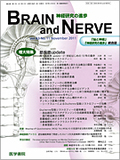Japanese
English
- 有料閲覧
- Abstract 文献概要
- 1ページ目 Look Inside
- 参考文献 Reference
はじめに
筋ジストロフィーは多くの病型で心筋障害を合併することが知られている。筋ジストロフィーの心臓合併症は,dystrophinopathyで代表される固有心筋の障害によるいわゆる心不全と,筋強直性ジストロフィーやEmery-Dreifuss症候群などで頻発する特殊心筋による刺激伝導障害に大別できる。本稿では,筋ジストロフィーの中で最も多数を占めるDuchenne型筋ジストロフィー(Duchenne muscular dystrophy:DMD)の心筋障害により生じる心不全,特に慢性心不全の臨床的な病態評価と治療法について解説する。
Abstract
Heart failure (HF) is a fatal complication in many muscular dystrophy cases and has become the most common cause of death in Duchenne muscular dystrophy (DMD) since 2001. HF deaths in DMD occur in young patients and increase, along with respiratory failure, in older patients. Managing HF, therefore, is the most important component of DMD treatment. Management of HF is necessary in DMD patients of all ages because myocardial damage progresses regardless of age and disability. Electrocardiography, echocardiography, myocardial single-photon emission computed tomography (SPECT), and natriuretic peptides are used for the diagnosis of myocardial damage and chronic HF. Tissue Doppler echocardiography is in particularly useful for early detection of minute myocardial damage and dysfunction in DMD.
The first-line drugs for chronic HF are angiotensin-converting enzyme inhibitors,and the prognosis of DMD patients has been improved using these drugs and beta-blockers. Diuretics are added in the presence of pulmonary congestion. Digoxin is most effective at a blood level of 0.5-0.8 ng/mL because of its pharmacokinetics in DMD. Surgical treatment may be necessary in cases of intractable HF. Cardiac resynchronization therapy (biventricular pacing),a treatment with an artificial pacemaker,is indicated for cases that meet specific criteria,including HF with ventricular dyssynchrony. Applications of partial left ventriculectomy (Batista procedure) and left ventricular assist devices in muscular dystrophy are likely in the near future.

Copyright © 2011, Igaku-Shoin Ltd. All rights reserved.


